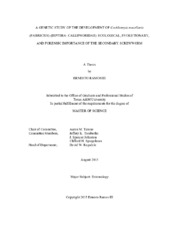| dc.description.abstract | Blow flies (Diptera: Calliphoridae) are carrion feeding insects that perform a critical ecological service by recycling nutrients throughout temperate and tropic regions of the world. Some members of this guild are parasites of vertebrates and important to medical and veterinary research. Given their relatively predictable life cycles and close association with carrion, estimating blow fly age from human and animal remains can also be informative in legal investigations. In the southern United States, the blow fly Cochliomyia macellaria (Fabricius), known as the secondary screwworm, is a common primary colonizer of carrion, can parasitize mammals, and often is used as evidence in forensic investigations. Accordingly, studies of this organism can contribute to our basic knowledge of decomposition ecology. Life history traits are important to the evolutionary fitness of any organism and yet, there are very few studies on genetic variation of these phenotypes in blow flies even though knowledge of that variation would aid in medical, agricultural, and forensic endeavors.
Natural genetic variation in development time and body size has been observed in C. macellaria. To further evaluate genetic variation in immature development rates of this species, an artificial selection experiment was performed on three Texas populations. After 23 generations of selection at 25°C, all experimental populations selected for faster development exhibited approximately a 1.5 days decrease in mean development times as compared to the founding generation, while those bred for slow development required another 3.5 days of development. The six selected lines were subsequently reared in different thermal environments (20°C, 25°C, and 30°C), to evaluate their phenotypic plasticity in development time, pupal mass, and immature viability. Under different thermal exposures, C. macellaria developed slower at cooler temperatures and faster at warmer temperatures with a difference between selection groups of approximately 3.7 days at 30°C, 5.6 days at 25°C, and 7.9 days at 20°C. Slow developers reared at 25°C and 30°C had significantly heavier pupal mass (48.38-51.85 mg) than the cooler and slower selected lines (38.00-40.99 mg). Immature viability also differed between selection regimes, with survival to adulthood ranging from 54.8-86.7% for all blow flies studied here. Significantly higher lethality was observed in the slow developing blow flies, especially at cooler temperatures. The results of this work suggest that Cochliomyia macellaria harbor considerable genetic variation for development time, are more likely to be faster developing in the wild, and that alleles that slow development alter correlations among life history traits in a temperature dependent manner. This study of the natural variation in basic blow fly biology provides valuable information regarding the evolutionary biology and ecology of the species. The selected lines provide the basic material to conduct further genetic studies to identify markers associated with variation in development time. These markers could ultimately be used to improve accuracy in estimating the ages of immature secondary screwworms for forensic purposes. | en |


